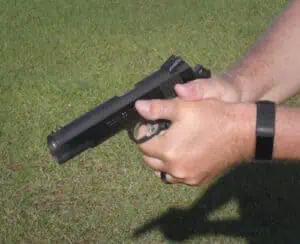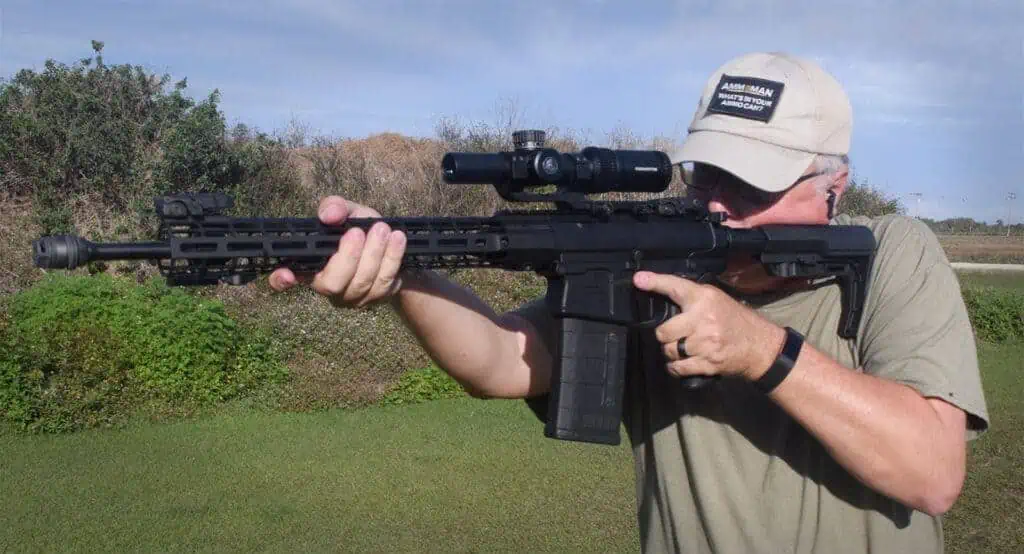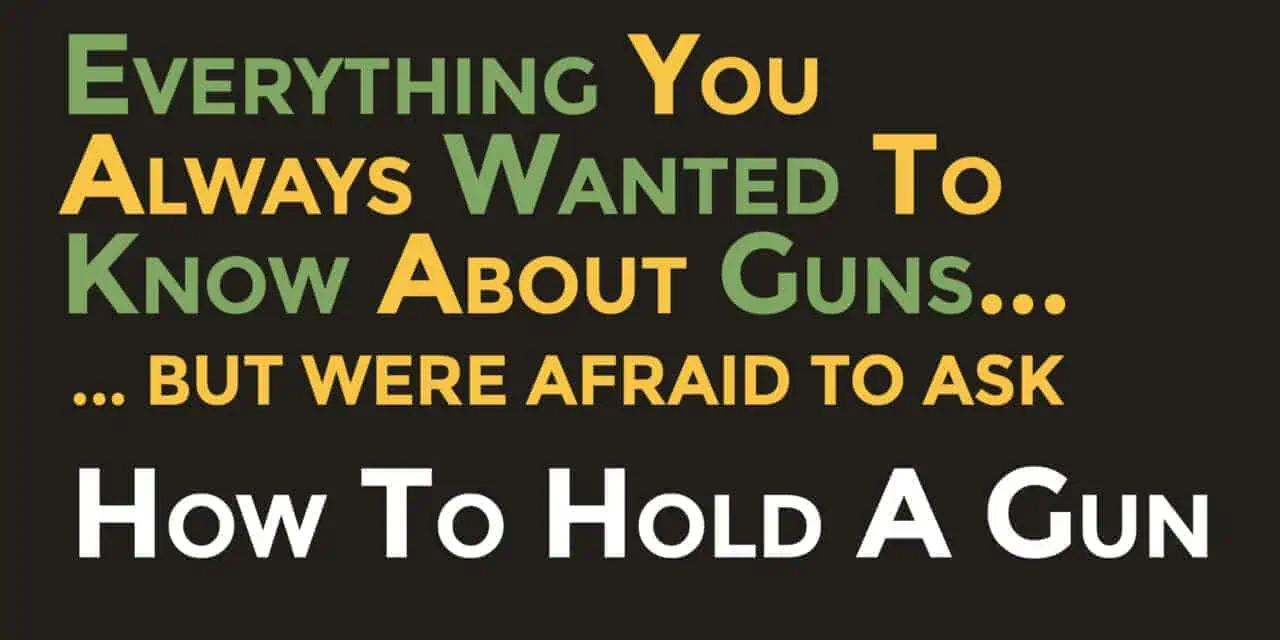Basic Firearms Operations: How To Hold A Gun
Remember your first driving lesson? Did you ever stomp on the brake instead of the gas pedal, or worse still, hit the gas instead of the brake? Remember how awkward it felt to try to coordinate the steering wheel, gas and brake (and maybe the clutch and gear shift as well)? All those feelings of excitement, possibility and little bit of terror are exactly what people who are new to guns feel the first time they handle a gun. You didn’t learn how to drive overnight. It took practice and patience for you to become a good driver. The same is true with firearms ownership. You learned how to drive, new gun owners need to learn how to hold a gun.
Properly holding your gun as you shoot is important for three reasons.
1.) Your Safety
Your safety depends on you knowing how to hold a gun correctly. I recently watched a new shooter pick up a pistol and try to shoot it with their support hand thumb braced on the webbing of their strong hand. This put their support thumb right where the slide would hit as the gun cycled, which it did, resulting in a trip to the first aid kit to patch themselves up.
2.) The Safety of Those Around You
This doesn’t just impact you. Knowing how to hold a gun is important for the safety of everyone at the range. Dropping a gun during recoil because of an improper grip places you and everyone near in danger.
If you’re shooting and your gun falls out of your hand, let it fall. Pretty much every modern firearm has undergone some sort of drop testing to make sure they don’t discharge if they fall out of your hand. Trying to grab your gun on the way down means you might grab it by the trigger. This in turn might cause a negligent discharge, and that might be bad for you and everyone around you.
3.) Consistent Accuracy
There is a strong connection between knowing how to hold a gun and making fast, repeatable hits with your gun. A proper grip keeps your gun under control as it recoils and allows you to properly align your sights as you bring your gun up to shoot. A good grip also means quickly re-acquire your sights if a follow-up shot is needed. The bottom line is, there really are no downsides to learning how to hold a gun the right way. Let’s look at how to do that, with three common types of firearms.
How To Hold A Semi-Auto Pistol
Holding a semi-automatic pistol correctly begins with the strong hand, aka the hand you write with. The gun should be up high on your hand, with webbing between your thumb and index finger pressing up against the back of the grip. Be careful, as too high of grip means that you could get a bite taken out of your hand as the gun cycles.
The middle finger of your strong hand should snug up as tight underneath the trigger guard as possible, with the other fingers wrapping around the grip and your index finger off the trigger (Rule 3, remember?). The pistol is going to recoil back towards you, so the closer your hand is to that backwards motion, the more that leverage you’re going to have getting your gun back on-target as it recoils.
How To Hold A Gun With Both Hands
 The placement of your support hand (your other hand) on the pistol is as important (or maybe more important) than the placement of your strong hand. If your grip is a vise, your support hand is the outer jaw, so gripping the gun tightly with your off hand (especially the index finger), is of utmost importance. The index finger of your support hand should wrap right on top of the middle finger of your strong hand, creating a tight bond that will keep the gun under control as you press the trigger.
The placement of your support hand (your other hand) on the pistol is as important (or maybe more important) than the placement of your strong hand. If your grip is a vise, your support hand is the outer jaw, so gripping the gun tightly with your off hand (especially the index finger), is of utmost importance. The index finger of your support hand should wrap right on top of the middle finger of your strong hand, creating a tight bond that will keep the gun under control as you press the trigger.
Where you place your thumbs when both your hands are on the gun is a matter of some debate. For years, I snugged both of my thumbs up against the side of the pistol, pointing them towards the target. Recently, however, I’ve started to hold both my thumbs so I’m giving a “thumbs up” gesture with both thumbs. I’ve found that this small change allows me to grip the gun more with the index finger of my support hand, which in turn gives me a better sight picture before, during and after recoil.
How To Hold A Gun When It’s A Revolver
Holding a revolver is very similar to holding a semi-automatic pistol. Both your strong hand and your support hand are placed more or less the same way on a revolver as they are on a sem-auto. There is one slight difference, though. With a revolver, your support hand thumb should wrap around the back of your strong hand, something that is potentially very painful to do with a semi-automatic gun.
This is done for two reasons. The first is to get your thumb out of the way of the gap between the cylinder and frame of the revolver. Hot, rapidly-moving gasses from the firing of the gun leak out from that gap, and they can cause serious injuries if your thumb is in their path.
The second reason to hold your support thumb behind your strong hand when shooting a revolver is so that it is in-place if you need to cock the hammer on your gun. This, of course, is not needed if your revolver has a shrouded hammer. However, keeping your thumb away from the cylinder gap is still a good habit to get into, no matter if your gun has an exposed hammer or not.
How To Hold A Rifle
 There are pages and pages of information about how to hold a rifle in various shooting positions. However, for the purpose of this article, we’re going to talk about holding one of America’s most popular rifles, the AR-15, as if you were going to use it in a 3 Gun match or defensive shooting encounter.
There are pages and pages of information about how to hold a rifle in various shooting positions. However, for the purpose of this article, we’re going to talk about holding one of America’s most popular rifles, the AR-15, as if you were going to use it in a 3 Gun match or defensive shooting encounter.
Your strong hand should fall naturally onto the grip of the rifle. The webbing of your hand should once again be high up on the grip. Make sure (once again) that your finger is straight and placed on the side of the gun, rather than on the trigger. If you’re right-handed, your thumb should be able to easily reach the safety in this position. If you’re like me and shoot rifles with your left hand, well, that’s why they make ambidextrous safeties, I guess.
Where your support hand should go when shooting an AR-15 is a matter of some contention. Some people like to place their hand up close to the magazine well of the rifle. Others like to move their support hand farther out on the rifle in what’s called a “C Clamp” grip. I’ve tried all of them, and for myself, I prefer to hold onto the handguard of an AR about halfway along its length. Your experience might be different, though. Practice and training will show you what works best for you, and be prepared to change how you hold your gun as you experience and skills change.
Learn How To Hold A Gun Correctly, Without Firing A Shot
Spending a few moments in dry fire each day will help a great deal with learning how to hold a gun. You’ll gain a better understanding of how your hands are placed on the gun, and how the gun feels as you move it around. Safely performing dry fire practice for just a few moments each day away from the range will have a dramatic effect on your performance at the range. You’ll soon find out that not only do you know how to hold a gun correctly, but also aim and hit your target. After all, safely shooting guns is a lot of fun. Safely shooting guns and hitting your target? Well that’s even more fun.


